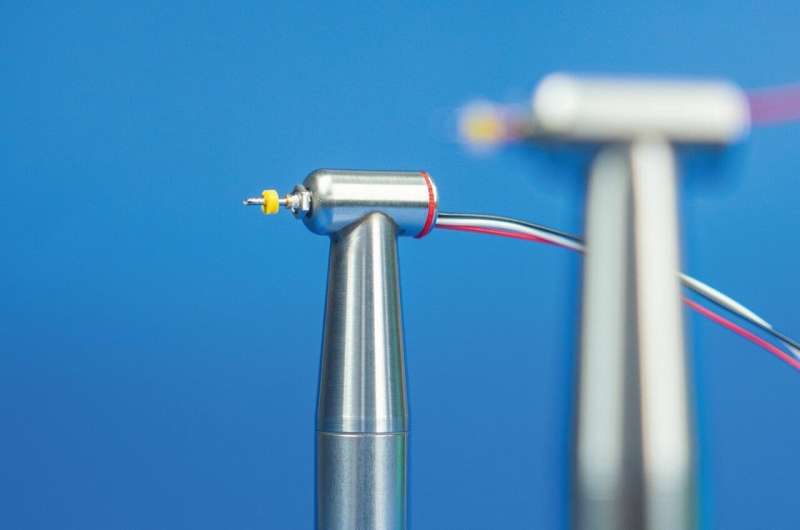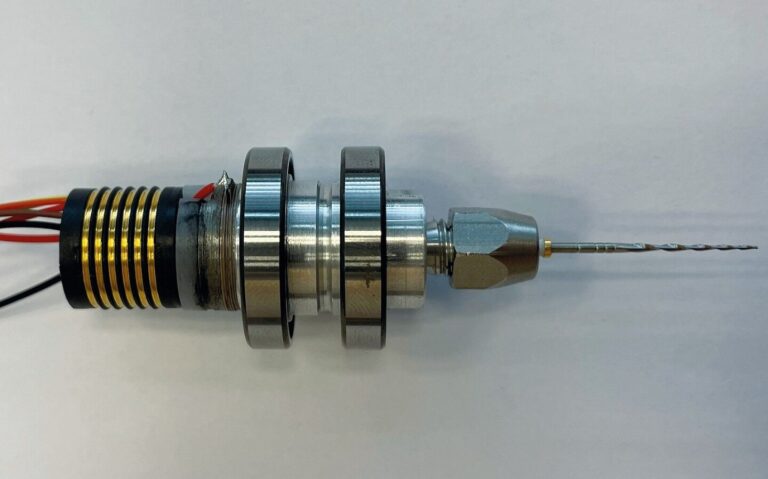Demonstration of dental files with integrated piezoceramic stack actuator. Credit: Fraunhofer-Gesellschaft
When performing root canal treatment procedures, dentists must insert a file deep into the root canal to remove the inflamed tissue. The rotating file often gets blocked and needs to be cleaned regularly.
Researchers at the Fraunhofer Institute for Ceramic Technologies and Systems IKTS have now developed a piezoceramic stack actuator that overlays rotary motion with a vibrational motion. The file is not blocked as often, which means that procedures on patients can be completed more quickly. This technology is also useful for other medical applications, for example in the diagnosis and treatment of cancer.
Fraunhofer IKTS will present a demonstration at the joint Fraunhofer stand at WRITE medical engineering exhibition in Dusseldorf (Hall 8a, Booth G10).
A new development of the Fraunhofer Institute for Ceramic Technologies and Systems IKTS will be of interest to anyone with root canal treatment experience. The procedure is often necessary if a patient has a deep cavity and the roots of the tooth are inflamed. To save the tooth, the dentist opens it and removes the inflamed tissue inside the root canal using a rotary file. Even when local anesthetic is used, the procedure is exhausting and stressful for both the patient and the dentist. This is partly because the tissue removed from the root canal sticks to the file and blocks it.
As part of the joint research project IPUCLEAN (intelligent piezoelectric ultrasound system to improve the cleaning and cutting ability of nickel-titanium alloy root canal files), researchers at the Fraunhofer IKTS in Dresden have created an innovative file that reduces the dentist’s workload and shortens process times. To achieve this, under the leadership of Dr. Holger Neubert, head of the Smart Materials and Systems department, the team developed a miniature piezoceramic stack actuator that overlays file rotation with axial vibration in the ultrasonic frequency range.
A dental file that rotates and vibrates
A typical dental file rotates approximately 200 times per minute under the power of an electric motor in the handpiece. It is inserted into the root canal and periodically removed and reinserted. Some of the removed tissue ends up as a sticky mass attached to the file, which reduces its cleaning ability and stresses the tool. Although these dental files are made of a super-elastic nickel-titanium (NiTi) alloy, there is an increased risk of the files breaking when under stress. Because of this, they must be constantly removed and thoroughly cleaned.
Neubert explains the advantages of using the piezo-ceramic stack actuator: “By overlaying the rotation with axial vibration, the file clogs less quickly, which means it doesn’t need to be cleaned as often. Dentists can then focus much more in Their complex root canal work. The risk of file breakage is also reduced.”For patients, this means that their root canal treatment is over much faster.


The demonstration will be presented at the Fraunhofer stand at COMPAMED in Dusseldorf. Credit: Fraunhofer-Gesellschaft
Fast, small and efficient: Piezoceramic stack actuators
“The basic idea of combining the two movements of the dental file came from the specialists of the Department of Dentistry at the Rostock University Medical Center. We used piezoceramic stack actuators as the movement element because they are more capable of meeting the special requirements for vibration amplitude and frequency, size as well as feed voltage,” explains Neubert. Gebr. Brasseler GmbH & Co. KG coordinated the IPUCLEAN project. Dentists at the Department of Dentistry at the University Medical Center Rostock have already tested the technology on artificial teeth, which has resulted in positive comments.
Piezoceramic actuators offer several advantages. They are small and compact, work quickly and accurately, are easy to control and lose minimal heat. Stack actuators consist of several layers stacked on top of each other that work together to increase the displacement of the actuator. Because of this, IPUCLEAN project scientists were able to make the hand-held device small enough to easily fit into the tightest spaces in patients’ mouths. Another advantage is that Fraunhofer IKTS has manufactured the stack actuator from lead-free materials. This already meets the future requirements of the European RoHs Directive and means that the device is free of harmful substances.
Further medical engineering applications
Fraunhofer IKTS is leading the way in unlocking the enormous potential of piezoceramic materials. The researchers are looking at further medical applications for the technology, particularly low-frequency ultrasound transducers with high penetration depth for tomography. These piezoceramic transducers have been compressed so much that it is possible to fit 2,000 of them into a conventional CT system. This enables high-resolution 3D imaging of the human body for diagnostics.
High frequency ultrasound transducers are in high demand in dermatology, among other fields. They provide accurate high-resolution images at shallow penetration depths. Potential applications also extend to high-performance ultrasound transducers. These would use highly focused sound input to destroy specific areas of tissue, for example in cancer treatment.
“Piezoceramic components can be used in a wide range of applications and, thanks to their compactness and performance, are ideal for medical engineering. We are able to develop customized solutions to suit the needs of individual customers,” says Neubert.
Reference: Piezoceramics help shorten root canal treatments (2023, November 2) retrieved November 22, 2023 by
This document is subject to copyright. Except for any fair dealing for purposes of private study or research, no part may be reproduced without written permission. Content is provided for informational purposes only.


